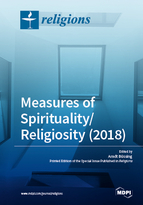Measures of Spirituality/Religiosity (2018)
A special issue of Religions (ISSN 2077-1444).
Deadline for manuscript submissions: closed (1 March 2018) | Viewed by 130003
Special Issue Editor
Interests: mind-body medicine approaches; spirituality and health; quality of life; coping; questionnaire development; integrative medicine; clinical studies; health service research; spiritual dryness; awe
Special Issues, Collections and Topics in MDPI journals
Special Issue Information
Dear Colleagues.
The interest in the topic of spirituality as an independent dimension of quality of life is continuously growing, and also the research questions start to change because also the fields of religiosity are changing, becoming more diverse and pluralistic. To address the new topics in health research, one may rely on standardized questionnaires. Several of these new questions cannot be easily answered with the instruments designed for previous questions, and thus new instruments are constantly developed. The number of instruments intended to measure specific aspects of spirituality is growing and it is difficult to value particularly the new ones.
This special issue intends to pay attention to some of the already established instruments (and to update the knowledge), but also to describe the features and intentions of newly developed instruments, which may have potential to be used in larger studies to develop knowledge relevant to spiritual care and practice. Some of these are rather ‘inclusive’ (embracing also secular concepts of spirituality, and may thus be less specific) and others are rather ‘exclusive’ (or specific for circumscribed religious groups, and thus not suited for varying denominations or a-religious persons).This issue should become a resource of relevant instruments in the wide range of organized religiosity, the individual experience of the divine, and the open approach in the search for meaning and purpose in life.
High quality manuscripts are welcomed which briefly describe the background of questionnaire development, its unique features and intentions, and a sound description of items, scales, and validity measures.
Prof. Dr. Arndt BüssingGuest Editor
Manuscript Submission Information
Manuscripts should be submitted online at www.mdpi.com by registering and logging in to this website. Once you are registered, click here to go to the submission form. Manuscripts can be submitted until the deadline. All papers will be peer-reviewed. Accepted papers will be published continuously in the journal (as soon as accepted) and will be listed together on the special issue website. Research articles, review articles as well as short communications are invited. For planned papers, a title and short abstract (about 100 words) can be sent to the Editorial Office for announcement on this website.
Submitted manuscripts should not have been published previously, nor be under consideration for publication elsewhere (except conference proceedings papers). All manuscripts are thoroughly refereed through a double-blind peer-review process. A guide for authors and other relevant information for submission of manuscripts is available on the Instructions for Authors page. Religions is an international peer-reviewed open access monthly journal published by MDPI.
Please visit the Instructions for Authors page before submitting a manuscript. Submitted papers should be well formatted and use good English. Authors may use MDPI's English editing service prior to publication or during author revisions.
Keywords
- spirituality
- religiosity
- faith
- secular
- health
- psychology






